Scrivener Scenario: Creating a Series Bible
By Gwen Hernandez | August 13, 2021 |
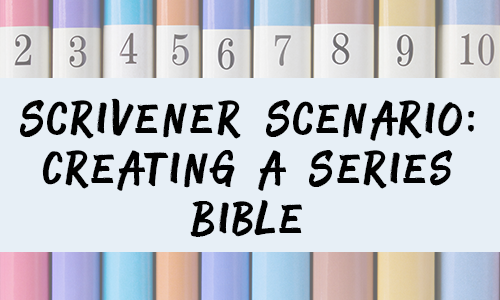
I was about halfway through book three in my series when I realized I needed a series bible. And since I write in Scrivener, creating it there was the obvious choice.
In case you haven’t heard the term before, a series bible (or series guide) is a collection of key details about everything and everyone in the world of your series, from the characters’ eye colors, birthdates, personalities, and the cars they drive, to their family history, the name of pertinent streets, and the timeline for major and minor events (current and backstory).
If you’d like to maintain a series bible in Scrivener, you’ll want to consider whether to put the series of books and the supporting material all in one project file, or to keep the books in separate files.
I use a hybrid version, so I’ll cover the pros and cons of each and give you a sneak peek at mine.
Here are some of the benefits to keeping a connected series of books—and all supporting info—in one Scrivener project.
- Need to change a name/word throughout the series? You only have to run Project Replace once.
- You can search for overused words and phrases across the entire series, and verify consistency of things like company names and descriptions of places or people.
- When you need to add a new character, you can do a quick search to ensure you haven’t used that name already. It’s easy to forget secondary characters’ names by book five.
- Tracking a story arc, timeline, or a character’s voice over several books in a series is much easier if the books are in the same project. Label, Status, and/or keywords are your friend here. Save a project search as a collection for a quick way to view all of the related documents or compile them into one file.
- Having all of your research, notes, character information, setting details, and other supporting materials in one place is a clear benefit.
- It’s a cinch to refer back to previous story lines or characters without opening a separate file.
- If you’re self-publishing and want to put a sample chapter into the back of a book, you’ll have easy access to the content without opening another project. Plus, you can re-use some of the same front and back matter items across the entire series.
- Having all of the books in one file makes it easier to create a boxed set.
Cons? There are a few.
- Large, possibly overly cluttered file, containing lots of research, notes, and images that only apply to a single book.
- The excess of PDFs, images, and web pages that could accrue in the project above might eventually make the file too big to back up or move to a different drive.
- For compiling purposes, you’ll either need to keep the current book in the Draft folder and put the other books elsewhere, or only select the book you want when compiling.
Ultimately, it’ll come down to personal preference. Here’s mine:
Despite all of the pros of having just one project file, I prefer to only have what I need at hand for the current book. Everything else is just clutter that stresses me out. So, for easy access to the series details, I keep the series bible open so I can quickly switch to it (via the Window menu, the Dock/Taskbar, or Command+` on the Mac) when needed.
When each manuscript is complete and published, I drag a copy of it over to the series bible project (you can drag files from one Binder to another). This way, I can quickly search all of my books in one go, rather than opening each book’s respective Scrivener file.
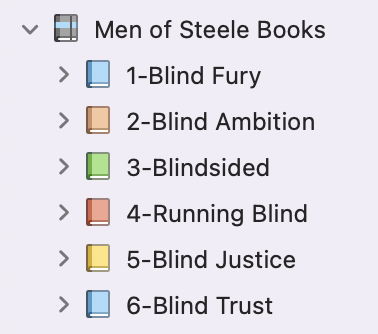
I’m constantly refining which details I collect and how I format them, but I’ve developed a fairly standard approach at this point. Below is the series bible file for my current series, displaying the files I’ve collected about a fictional location in the Corkboard view.
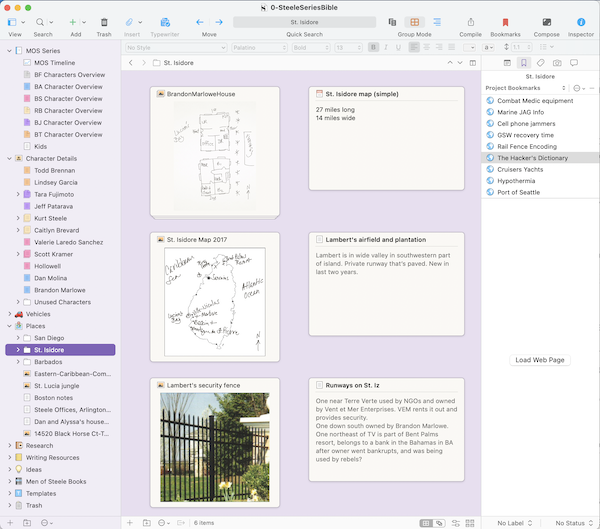
There’s a folder at the top of the Binder (left side) that contains character lists for each book, as well as the master timeline. The folder below that one holds the individual character sheets for my main characters (and a couple of major secondary characters).
There are also folders for information and pictures on characters’ vehicles, recurring settings, series-relevant research, general writing resources (e.g., story structure guides), a place to capture ideas for future books and titles, the entire published set of books, and character templates.
On the right-hand side, you can see the list of web pages I’ve bookmarked.
The only background information that gets transferred from a book’s project file to the series bible is the kind that applies to the more than one book in the series. Is this a recurring character or location? Did I just tell the reader they graduated from high school in 1998? Will her Piper Cherokee show up again in future stories? Will I need that website on CPR again? Those go in.
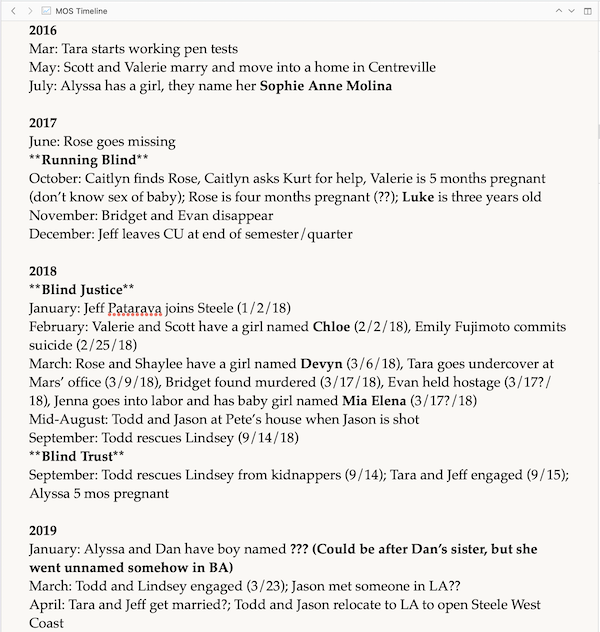
Partial shot of my series timeline, nothing fancy
One-off characters, research about a place they’ll never visit again, or information on a specific kind of wound won’t make it into the bible (though I can always change my mind if needed).
While I’m working on a book, I keep a running list of characters and the basic attributes I’ve given them on the page. Once the book is done, I try to remember to make sure the list is correct (because I get lazy or forget when I revise sometimes), and then I add it to the series bible.
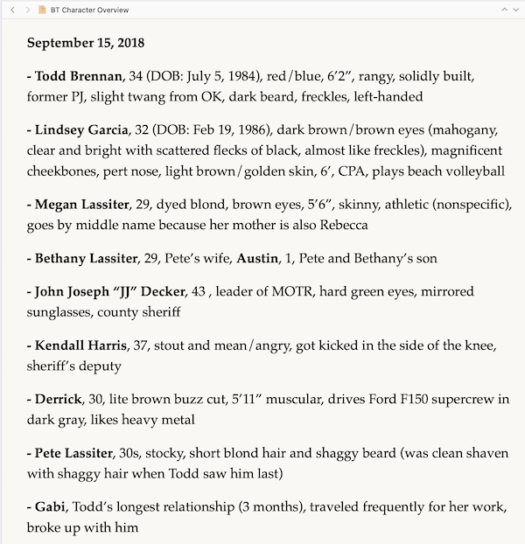
For each book, I also have a more detailed character sheet for the two main characters that I add to as I discover their history, characteristics, and personal tastes (can you tell I’m not a plotter?). This also goes into the series file.
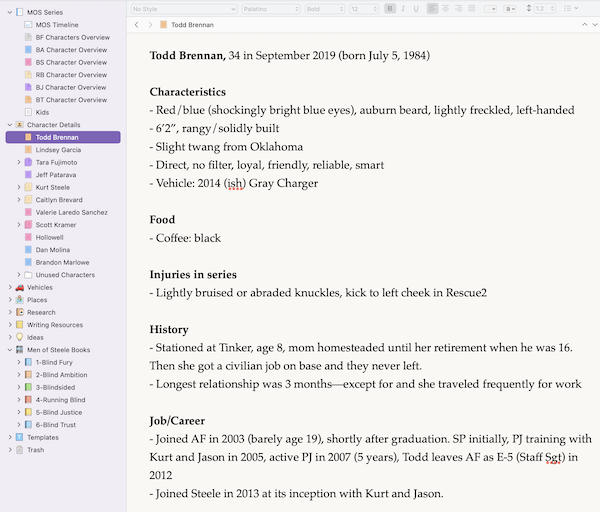
My way is just one example of what you can do. The beauty of Scrivener is that it doesn’t just flex to match your writing process, it can also flex to accommodate your series bible process.
Do you keep a series bible? What questions do you have about maintaining one in Scrivener?
[coffee]









Perfect! I use Scrivener for my writing projects, but it never occurred to me to make a master series bible in Scrivener. Doh. I know how I’ll be spending my weekend!
Sorry to give you homework, Anne! ;-)
Oh how I love Scrivener posts. I have a series bible, but there are separate files for the books. The reason I went that way was because I was worried about size, as you noted. I write women’s otherworld fiction so the novels tend to be longish. Too, the worldbuilding is extensive with files like Magic and Its Operation, Partials and Zycons, and Witchcraft. There are also character lists, a calendar, history, glossary, maps, and so on.
Fortunately, as I move from one book to the other, transferring new or updated bible files is as simple as dragging them across while both files are open. It takes seconds to drag them as a group.
I also have a project that holds all my novellas and, in that case, I do things more like you do since I’m not worried about size.
Thanks for sharing your process and setup, Christina! It’s always great to see how other people work.
I do still have a separate project for each book, but add the final MS to my series bible for easy searching across the series. And then I only bring in the bare minimum of supporting material. Dragging files between projects is one of my favorite features about Scrivener. ;-)
I confess I’m still on the fence for how to handle a series bible, including even using Scrivener or not for it. I tend to maintain a second doc (often just in Word or whatever), that is bible 1.0 as it pertains when I’m writing story 1.0. If I go to story 2.0, I copy over the bible as a new file called 2.0 too BUT not the stuff from the first story. I move / backup that up separately. I will have to think about this a bit more. I also try to limit the bible somewhat to the core features of each, not every ref I’ve ever made to what the back of their finger looks like. :)
Interesting, Paul. It really depends on what helps you get the writing done. Best of luck figuring it out!
I, too, love your Scrivener posts Gwen! The screenshots you’ve shared with live examples of how you use Scrivener to organize your work have been so useful to my evolving Scrivener skills over the years. I’ve actually clipped a few of them that go in my current project’s Research folder for easy reference. Thank you for all your posts & online classes—whenever I encounter a Scrivener newbie, or convince a hesitant writer to give it a try, I send them links to the appropriate UC blog post and to your Scrivener Classes website. Good luck with the next writing project!
Thanks, Luz! I’m so glad you’ve found the posts helpful. I appreciate you spreading the word. :-)
Thanks, Gwen! I’ve been wanting and waiting for a post like this for a long time. This is really going to help me put my series bible in order on Scrivener. Thank you so much!
Great, Lori! It’s a little work up front, but so worth the effort once you have it set up.